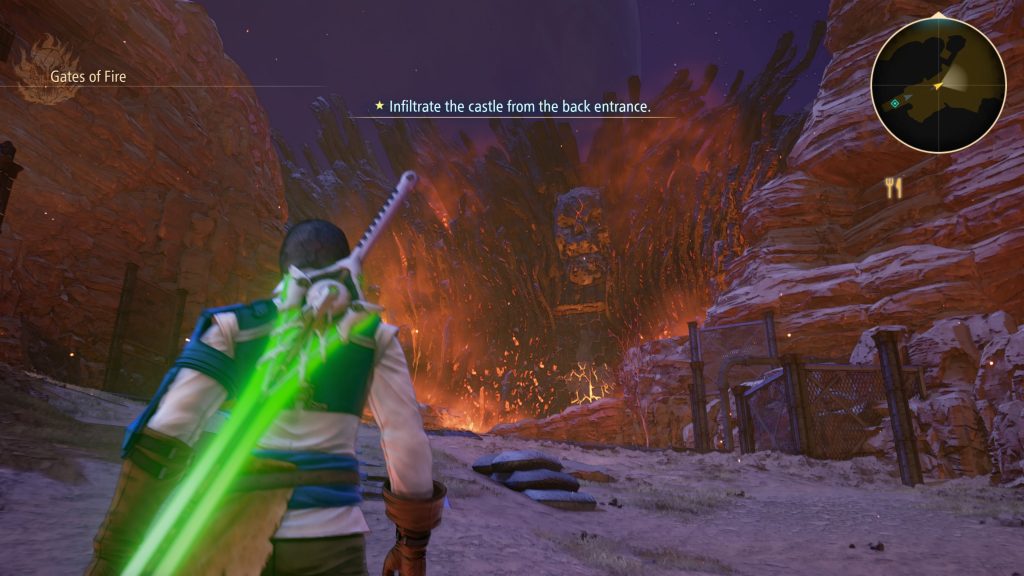
Full disclosure – while the Tales of series has existed for 25 years, and I have played and beaten many JRPGs, I have somehow managed to completely avoid them, making Tales of Arise my first game in the franchise. I might be the perfect demographic for it, then, as Tales of Arise marks a turning point for the series that’s meant to evolve the formula for the future. Sporting awesome visuals and fun, action-oriented combat, Tales of Arise makes for a compelling reason to start paying attention to the Tales series.
Two planets in orbit around each other, Dahna and Rena, are in conflict. While the medieval-level Dahnans initially worshipped Rena and believed it to be connected to their afterlife, they were caught unprepared when the technologically advanced native Renans suddenly invaded, easily conquering their world and subjugating their race into slavery. 300 years later, Dahna has been divided up into realms ruled by Renan lords, competing with each other for dominance with special powerful ‘cores’. Among this, a slave eventually known as Alphen, who has no memory nor can feel the sensation of pain, comes into possession of a powerful game-changing sword and takes up arms to free his people. Joining him is a Renan counterpart, a fugitive named Shionne, who can’t be physically touched and who’s necessary in order for the sword to function.
The story has a fairly straightforward start, with typical JRPG themes of an evil empire and a daring resistance fighting back against them, although things inevitably become more complicated. While characters aren’t as memorable as some other RPG’s I’ve played, I did have a lot of fun with the cast of Tales of Arise, as the party roster expands beyond Alphen and Shionne to include others like Law and Rinnel, and guest characters like Zephyr. There’s a fair bit of banter and tension between members, especially Alphen and Shionne, that’s relatively well played. Nevertheless, elements of the story often feel derivative from other franchises, although not executed poorly mind you, and well-rendered anime cutscenes punctuate key moments. Unfortunately more frequently, comic-style panels depict ‘skits’ which occur as characters interact on the journey, which feel cheaper and less dynamic.
Tales of Arise enjoys a very polished presentation, with in-game graphics being highly detailed yet also having an almost painterly quality, thanks to thin outlining around characters and environments. The style accentuates the detail and feel of each zone, from the firey pits of Calagaria to the frozen night-time fields of Cyslodia. On PS5, it all runs at a smooth frame-rate as well, even throwing in some neat particle effects in major encounters. Likewise, the soundtrack has a super cool opening theme, as well as memorable and well-orchestrated music for exploration and battle.
Following the trend of other modern JRPGs, Tales of Arise features a real-time action battle system, that plays more like Final Fantasy XV or even a very light version of Devil May Cry. For instance, as Alphen you’re able to execute simple attacks and dodge rolls, as well as map three abilities that can deal greater damage, or even launch enemies in the air to juggle them for mid-air combos. Generally, you’ll be focused on what your main character of choice is doing, as party members will act on their own accord thanks to a tactics system that allows you to set conditions for their actions, although you are able to switch characters. It’s definitely a simplified system, but I have to admit I always enjoyed the combat a great deal thanks to the combo system feeling responsive and fluid.
Using ‘Boost’ abilities from team-mates allows you to call on extra powers, and if you can wear down your enemies enough you can unite with your friends for spectacular battle-ending Boost Strikes. Staggering enemies is also a lot of fun, and often necessary in boss fights to deal greater damage, as often bosses can otherwise become damage-sponges with huge sectioned life-bars you need to wear down. Speaking of, there are some spectacular boss fights to see throughout Tales of Arise, starting with an impressively huge monstrosity which closes out the game’s prologue.
Battles take place within small arenas, which the game transitions into when you encounter enemies on the field. The fact these arenas exist at all feels like a throwback to older JRPGs, and they can annoy at times given their limited size, as you can find yourself stuck against a wall combo’ing enemies with not a lot of room for movement.
The new ‘CP’ mechanic in Tales of Arise is interesting in adding a layer of difficulty and strategy to the game, although it often feels quite limiting. The idea is that you have a set number of ‘Cure Points’ available, which can be replenished with certain items, but mainly through resting at inns and camping (a mechanic that very much resembles FFXV, complete with recipe collection and cooking). Cure Points are used by restorative magic in battles, and once you’re out, you’re out – having to rely on items instead. Not only that, Cure Points can be used for other means in the field as well, such as curing NPC’s in exchange for rewards, or opening new paths. It is an interesting idea, forcing you to consider whether you keep your Cure Points for battle or use it in exploration, but it can get annoying finding yourself frequently running out in the middle of big encounters because you tried to heed your natural instinct beforehand to explore everything.
Exploring the world of Tales of Arise is also more fun than your bog-standard JRPG, with some neat inclusions like basic platforming jumps up ramps and over gaps. You can survive falls into lower areas, where there’s frequently goodies stashed and ladders leading back up, as well as swim through rivers and lakes to dive and pick up geld and loot. A very useful fast travel system is implemented in the map, accessible at almost any time – although certain locations go offline for tenuous reasons occasionally.
Character improvement is done through circular skill wheels which unlock at certain points in the story or characters’ development, named after aspects of their personality. It’s a way of gating development, I suppose, to make sure you don’t get too powerful before the appropriate moment, but it also feels a little limiting, especially compared to other JRPGs where you can develop characters into any class or path immediately.
There’s also systems for crafting and improving weapons and accessories, along with 70 sub-quests which you can find dotted around the huge world. However, at times, the actual story campaign itself can slow down and task you with busy work that feels like you’re just completing sub-quests for a while, before eventually picking back up, and even moving along too fast at times, sometimes feeling uneven.
Tales of Arise nevertheless kept my attention throughout, and as an introduction to the Tales series, I can’t deny that I had a lot of fun. While even as a newcomer I can tell certain aspects have been modernised to be simpler or more paired back. However, I still found the combat rewarding and enjoyable, the visuals pretty, especially on PS5, and the story and characters engaging. If you’re like me and you’ve never taken a look at a Tales game, Tales of Arise seems like a great entry point to get onboard with the series.
This review is based on code provided by the publisher for PS5, which unlocked the Ultimate edition of the game.
-Beautiful art style and world, runs buttery smooth on PS5 -Fun action-style combat lets you juggle and combo enemies with ease -Effective, if derivative story, and fun characters -Exploration rewarded, and plenty to do
-Cure Points mechanic is interesting, but often limiting -The game can sometimes slow down with busy work, or feel like it's speeding through plot










